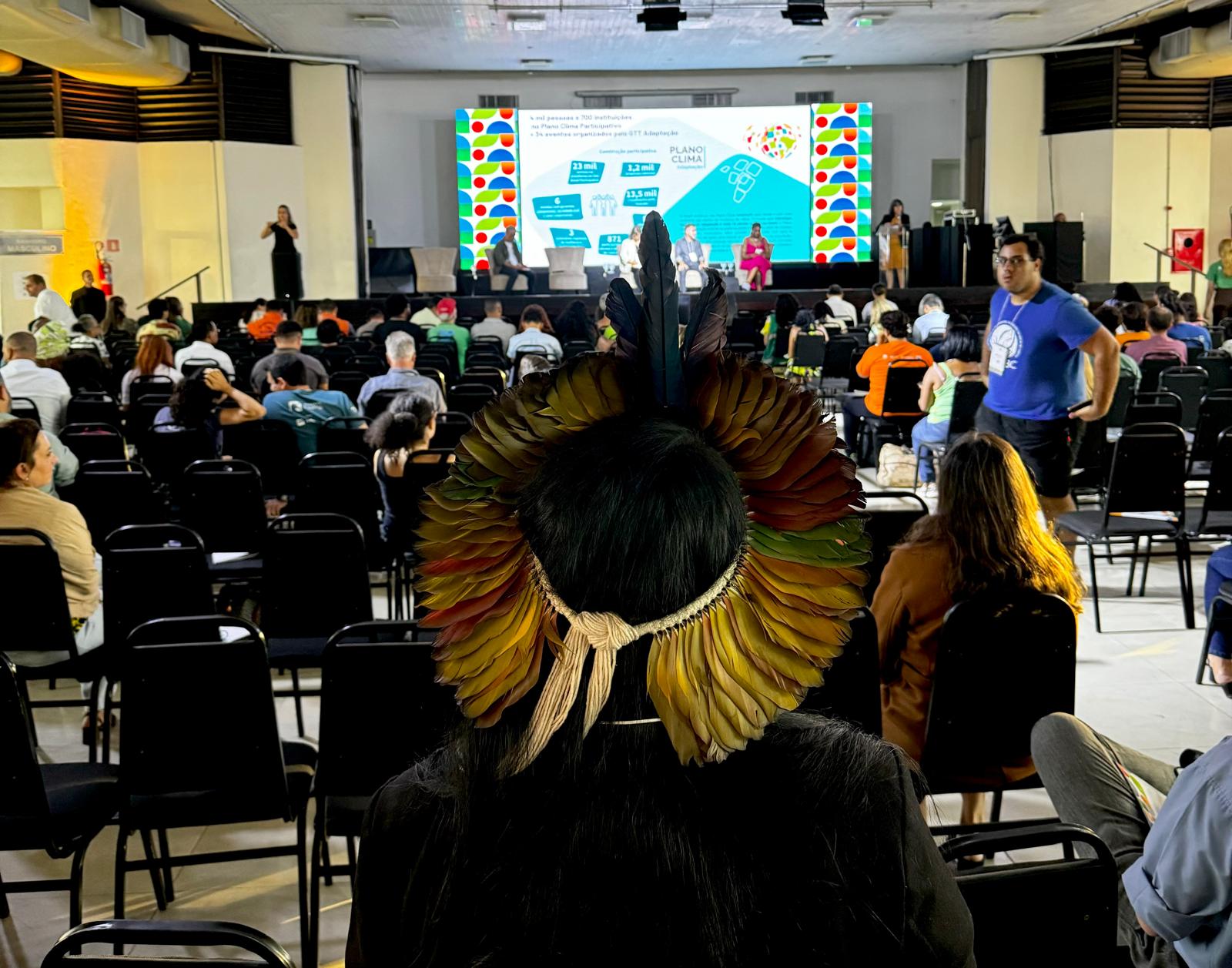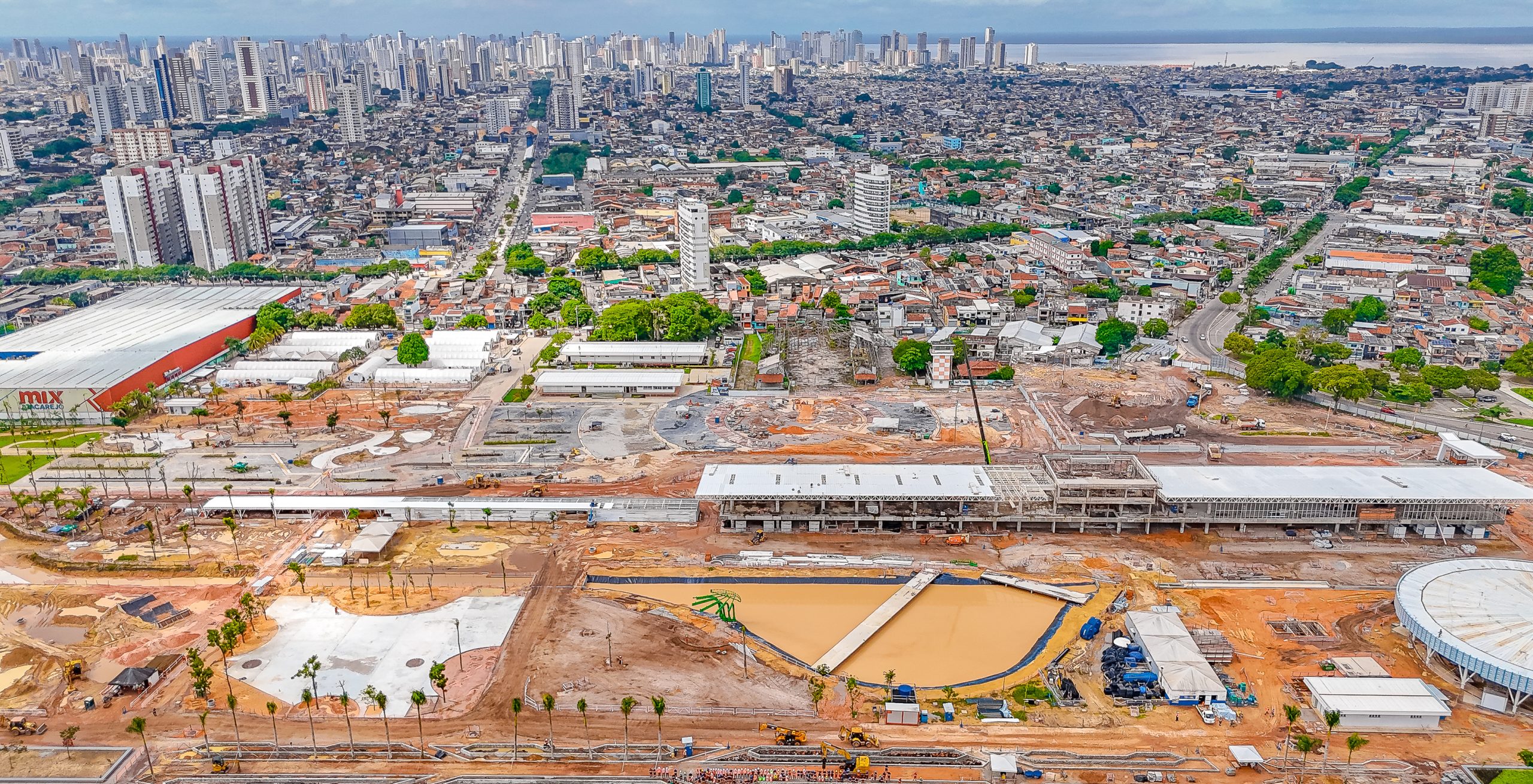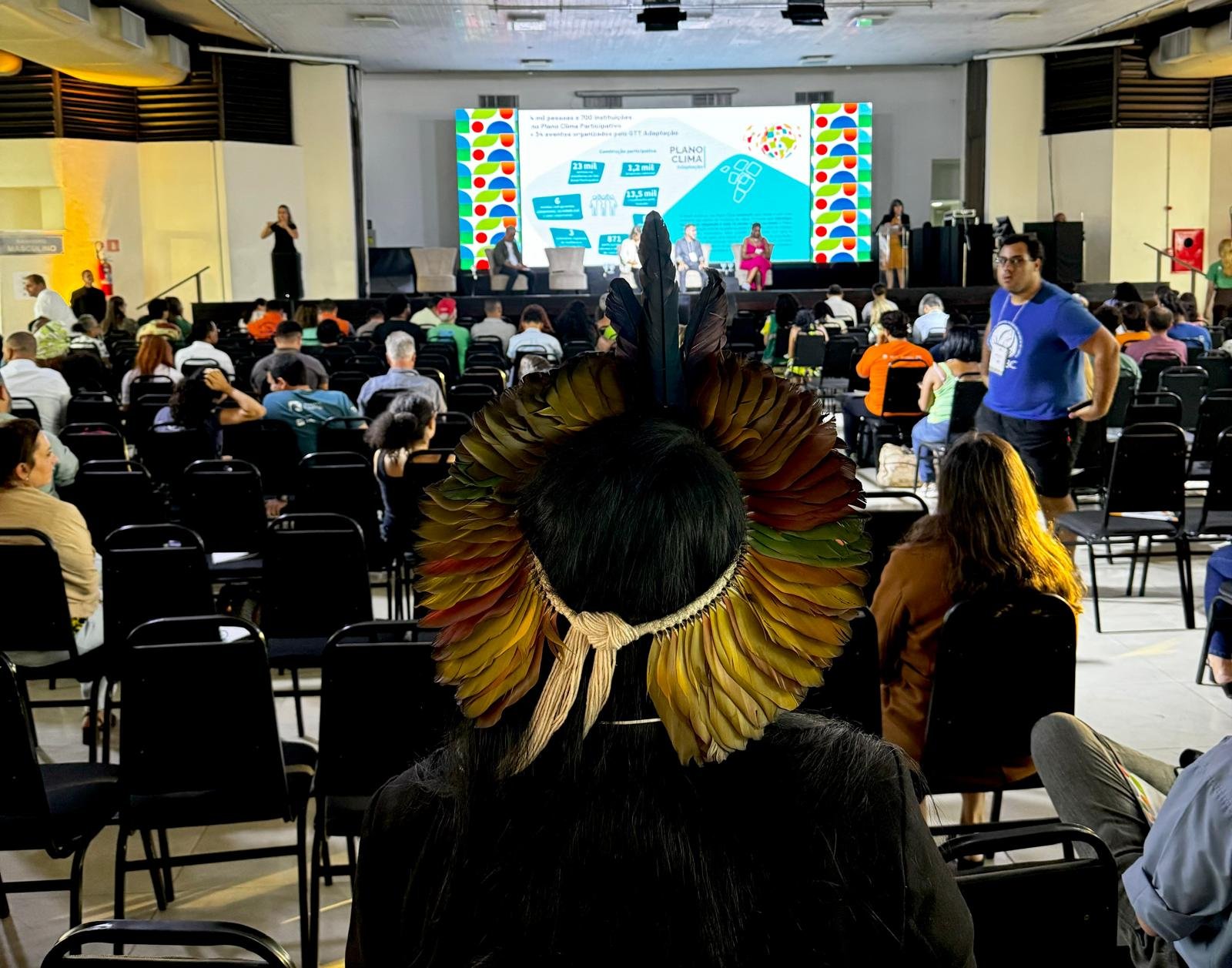
Clique aqui para Português
 This article is part of a series created in partnership with the Behner Stiefel Center for Brazilian Studies at San Diego State University, to produce articles for the Digital Brazil Project on environmental justice in the favelas for RioOnWatch.
This article is part of a series created in partnership with the Behner Stiefel Center for Brazilian Studies at San Diego State University, to produce articles for the Digital Brazil Project on environmental justice in the favelas for RioOnWatch.
About the author: Kaolin Maxakali, of the Maxakalí indigenous ethnic group of Brazil, is an independent journalist, community reporter, coordinator of the Independent Media Collective (MIC) and communicator at the Association of Indigenous Peoples (APORI). She currently lives in Coelho Neto, in Rio de Janeiro’s North Zone.
The climate crisis is a global phenomenon, but its impacts are deeply unequal. While wealthy nations and multinational corporations are the largest emitters of greenhouse gases, it is predominantly marginalized groups in the Global South—in Brazil represented by indigenous peoples, quilombola [historical spaces of Black resistance] communities, informal settlements and traditional fishing communities—who face the most devastating consequences.
Despite this, the communities on the front line of environmental impacts are rarely central in shaping climate policy, whether via local, national or international forums. The exclusion of these groups is rooted in a system that normalizes their political invisibility. While they face the impacts of predatory extractivism or environmental degradation on a daily basis, their presence and knowledge—essential to combating climate change—remain absent from ‘expert’ panels and negotiations.
This exclusionary dynamic is reproduced across all decision-making spaces—from city councils to United Nations conferences, wherever decision-making power resides. As a result, policies such as environmental licensing and urban zoning are imposed without any effective mechanisms for public participation.
Large-scale projects are approved in public hearings held at times inaccessible to the affected groups. Information is shared only through formal channels, such as official gazettes and institutional websites. As a result, communities are not informed—in accessible language—about the impacts of these mega-projects, including forced evictions, increased flooding, and landslide risk.
At the same time, authorities purposefully ignore existing spaces of grassroots organizing, such as residents’ associations and community councils, which could serve as a foundation for participatory practices. The City Statute provides for public participation in decisions of public interest. This concrete participation could entail prior territorial assemblies, with translation into native and immigrant languages, as well as adaptations for functionally illiterate residents; and the creation of community committees with veto power over interventions that directly impact their homes and areas.
The result of this State negligence is a climate policy that, by failing to recognize these voices as legitimate knowledge holders, perpetuates a cycle of injustice in which those most impacted are precisely the least heard.
Those most impacted are precisely the least heard.
Environmental Racism, Structural Inequality: Impacts in the Favelas and Peripheral Areas of Rio de Janeiro
The concept of environmental racism was originally coined by activist Benjamin Chavis in the 1980s, during protests against the establishment of toxic landfills in majority-Black communities in Warren County, North Carolina, USA.
Brazilian researcher Tania Pacheco points out that environmental racism does not require explicit intent, but takes shape through racialized impacts, such as land grabbing and mining on indigenous lands. Thuane Nascimento, from Perifa Connection, emphasizes that climate justice is essential for peripheral communities, which face daily precarious living conditions and environmental racism. Rejany Ferreira, a geographer with the CCAP Network, a local organization in Manguinhos, in Rio’s North Zone, adds that in favelas, environmental issues are expressed through a dual exclusion: chronic lack of sanitation and political marginalization.
In Brazil, this phenomenon is reflected in the systemic exposure of Black, indigenous, and peripheral communities to numerous risks—from water contamination caused by the illegal use of mercury in mining in Tarumã, a neighborhood in Manaus home to migrant indigenous peoples, to air pollution and landslide risks driven by real estate expansion in the Jaraguá Indigenous Territory, in São Paulo. Additionally, around 70% of Brazil’s population without access to sanitation is Black, brown, or indigenous. Among indigenous people living in urban areas outside of indigenous territories, access to water is 3.7 times more precarious (10.08%) than for the rest of the urban population (2.72%).
The abandonment of Rio’s favelas by public authorities who neglect environmental planning and investment in vital infrastructure is often worsened by overcrowding, lack of sanitation, and absence of natural ventilation. The absence of effective public policies turns these territories into sacrifice zones, where the right to health is directly impacted by a perverse cycle of socio-environmental exclusion and institutional neglect. This reality repeats itself with even crueler nuances in other peripheral areas of Greater Rio. Examples include the Coelho Neto favela complex and its surroundings, and the Rio das Pedras and Faria-Timbó rivers—now completely polluted by untreated sewage and industrial waste. Once spaces of leisure, work, and income, they have become vectors of disease and contamination for favela and river communities.

In Belford Roxo, in Greater Rio’s Baixada Fluminense region, environmental racism is evident in the normalization of annual tragedies caused by flooding and landslides. The Botas River, silted up and poorly maintained, overflows with every heavy rain, flooding hundreds of homes. In January 2024, flooding caused 12 deaths in the state of Rio de Janeiro—nine of them in the Baixada Fluminense alone. Some cities in the region remained underwater for 36 hours after the rain.
Despite its closure in 2012, the Gramacho landfill in Duque de Caxias still causes severe environmental impacts due to leftover waste. In the surrounding communities of Jardim Gramacho and Vila São João, contaminated soil continues to poison residents. Worse: the revitalization project that promised jobs and reparations ended up benefiting only large corporations, while the waste pickers who worked at the landfill for decades continue to live in extreme poverty.
These examples demonstrate how environmental racism operates in Rio de Janeiro: by normalizing precariousness in peripheral areas, systematically violating basic rights, and concentrating investment in already privileged areas. Favelas and peripheral areas continue to be treated as sacrifice zones—where Black, indigenous, and poor lives are considered disposable.
Despite the adaptation and resilience shown by groups most impacted by environmental racism—such as Marakanã Village, a Tupinambá ancestral territory of resistance where families practice traditional medicine and cultivate sacred herbs in the heart of Rio de Janeiro, right next to the world-renowned Maracanã soccer stadium—these community strategies are ignored in favor of climate technocracy. This model reduces the climate crisis to carbon equations, relying on mega-projects (such as desalination plants) and market mechanisms (carbon credits), often implemented without consulting the communities affected.
Decision-making forums need to solve this paradox, by creating mechanisms whereby ancestral knowledge has real weight in policies.
Decision-making forums need to solve this paradox, by creating mechanisms whereby ancestral knowledge has real weight in policies.
Lack of Representation in Decision-Making Forums
In March 2025, the Rio de Janeiro State Climate Conference—a forum meant to discuss public policy and sustainability actions—revealed profound contradictions between socio-environmental discourse and practice.
Participants denounced inefficient methodologies, the silencing of dissident voices, manipulation in the election of delegates, and disregard for vulnerable groups such as indigenous peoples, quilombolas, and persons with disabilities. A point of order had to be raised for civil society members to speak transparently before all participants and present their territorial concerns—whether related to quilombos, favelas, or indigenous villages. Among the main demands, calls for climate justice and the inclusion of environmental racism on the agenda were prioritized. In addition, the choice of a military venue (Costa Hall, managed by the Air Force) and the lack of accessibility raised questions about the coherence of a public event that was supposed to promote democracy and inclusion.
In Brazil, even public policies such as the National Adaptation Plan (PNA) often fail to adequately consult indigenous and quilombola groups, disregarding their ancestral knowledge. The Indigenous Climate Change Committee (CIMC), affiliated with the Articulation of Indigenous Peoples of Brazil (APIB), has been fighting to have its demands included in national strategies, but continues to face resistance from government and corporate sectors.
The participation of indigenous and peripheral communities is also limited by economic, bureaucratic, and language barriers in international forums, such as the COPs. Part of the United Nations Framework Convention on Climate Change (UNFCCC), the COPs are the main international and multilateral climate negotiation forums, bringing together representatives from 197 countries, as well as scientists, businesses, and civil society organizations each year.
The importance of the COPs lies in their ability to pressure nations into assuming historical responsibility and creating legal frameworks for the ecological transition. Despite the formal participation of indigenous peoples and vulnerable communities in parallel spaces, such as the Indigenous Peoples’ Pavilion, final decisions are dominated by governments and corporations—often resulting in unambitious or non-binding agreements.
Final decisions are dominated by governments and corporations—often resulting in unambitious or non-binding agreements.
COP30 and the Chance for an Inclusive Shift
The selection of Belém, in the northern Brazilian state of Pará, as the host city for COP30 in 2025 was welcomed with hope by socio-environmental movements in Brazil, who saw it as a chance to place the Amazon and its peoples at the center of the global climate debate. However, preparations for the event have already revealed deep contradictions, threatening to turn the conference into yet another chapter of exclusion and rights violations.

The genuine participation of indigenous and quilombola communities remains the main challenge. While corporations and governments invest millions in marketing strategies and delegations, indigenous and quilombola leaders face barriers such as costly and hard-to-obtain documentation, along with a lack of transparency in the selection processes for participation in COP30.
Corporate greenwashing is also a growing concern. Companies like mining giant Vale do Rio Doce—responsible for some of Brazil’s worst environmental crimes—have been making ambitious investments in COP30 infrastructure projects, which are already leaving a trail of violations in Belém. In addition, real estate speculation driven by the event risks displacing low-income residents from central areas of Pará’s capital.
COP30 in Belém represents a historic crossroads: it could either consolidate an exclusionary climate model that privileges corporate interests, or mark a radical shift toward socio-environmental justice. The true legacy of the conference will not be found in official documents, but in the ability to transform power structures—ensuring that forest peoples cease to be the object of policies and become active agents in building alternatives. The preparations already underway reveal that the path will be arduous, with rights violations and greenwashing attempting to drown out ancestral voices.
The true legacy of the conference will not be found in official documents, but in the ability to transform power structures—ensuring that forest peoples cease to be the object of policies and become active agents in building alternatives.
To ensure the conference does not end in empty rhetoric, now is the time to demand concrete mechanisms—such as binding quotas for representatives of traditional communities with full voting rights, and the creation of popular courts as official spaces for denouncing violations and their ethical judgment, with equal participation from civil society and indigenous peoples.
It is time to value the ancestral knowledge developed over millennia by indigenous peoples and traditional communities. Their knowledge includes biodiverse agroforestry systems (such as those of the Guarani people, which combine cultivation with forest preservation), wildfire control techniques (such as those of the Xavante people, who use controlled burns for regeneration), and water conservation practices (such as those of the Pataxó people, who protect springs through rotational use).
As Chief Raoni Metuktire says: “When the last tree falls, the white man will find out he cannot eat money.” COP30 will be the ultimate test of whether humanity can learn this lesson in time—or whether Belém will become the stage for yet another farce. The future of the climate is decided in the present, in the fight for radical inclusion and historical reparation.
COP30 will be the ultimate test of whether humanity can learn this lesson in time—or whether Belém will become the stage for yet another farce. The future of the climate is decided in the present, in the fight for radical inclusion and historical reparation.




